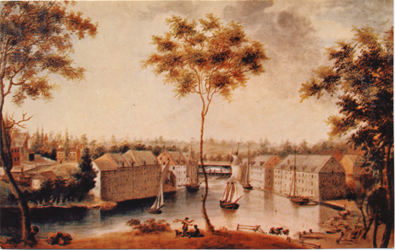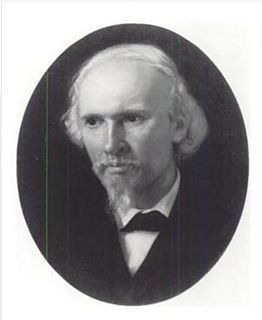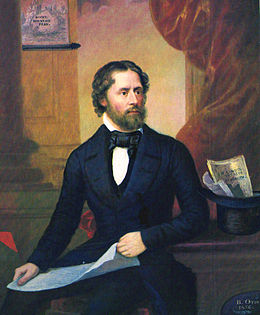
Thomas Sully was an American portrait painter. Born in Great Britain, he lived most of his life in Philadelphia, Pennsylvania. He painted in the style of Thomas Lawrence. His subjects included national political leaders, such as presidents Thomas Jefferson and John Quincy Adams, and General Marquis de Lafayette, and many leading musicians and composers.

Samuel Bell Waugh was a 19th-century American portrait, landscape, and moving panorama painter. His portrait subjects included President Abraham Lincoln and Ulysses S. Grant.

William Strickland, was a noted architect and civil engineer in Philadelphia, Pennsylvania; and Nashville, Tennessee. A student of Benjamin Latrobe and mentor to Thomas Ustick Walter, Strickland helped establish the Greek Revival movement in the United States. A pioneering engineer, he wrote a seminal book on railroad construction, helped build several early American railroads, and designed the first ocean breakwater in the Western Hemisphere.

Alvan Fisher was one of the United States's pioneers in landscape painting and genre works.

Dr. John McKinly was an American physician and politician from Wilmington, Delaware. He was a veteran of the French and Indian War, served in the Delaware General Assembly, was the first elected President of Delaware, and for a time was a member of the Federalist Party.

Samuel Worcester Rowse was an American illustrator, lithographer, and painter. He was most famous for his drawings of Ralph Waldo Emerson and Henry David Thoreau. Rowse is also well known for his lithograph, The Resurrection of Henry Box Brown at Philadelphia.
Dr. Henry Molleston, III was an American physician and politician from Dover, in Kent County, Delaware. He was a member of the Federalist Party, who served in the Delaware General Assembly, and was elected Governor of Delaware, but died before taking office.
James Madison Broom was an American lawyer and politician from Wilmington, in New Castle County, Delaware. He was a member of the Federalist Party, who served as U. S. Representative from Delaware.

Gustavus Hesselius was a Swedish-American painter.
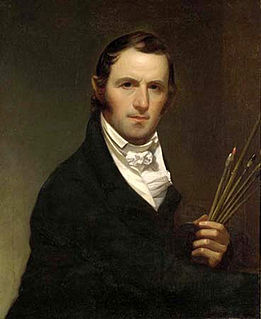
Jacob Eichholtz (1776–1842) was an early American painter, known primarily for his portraits in the Romantic Victorian tradition. Born in Lancaster, Pennsylvania in a family of prosperous Pennsylvania Germans, he spent most of his professional life in Philadelphia. A coppersmith by trade, he turned to painting and achieved both recognition and success despite being mainly self-taught as an artist. He is known to have painted over 800 portraits over the course of 35 years. Hundreds of his works are housed in art museums, historical societies, and private collections throughout the United States.

Pendleton's Lithography (1825–1836) was a lithographic print studio in 19th-century Boston, Massachusetts, established by brothers William S. Pendleton (1795-1879) and John B. Pendleton (1798-1866). Though relatively short-lived, in its time the firm was prolific, printing portraits, landscape views, sheet music covers, and numerous other illustrations. The Pendleton's work might be characterized by its generosity—each print contains a maxima of visual information designed for graphic reproduction.

John Nelson Shanks was an American artist and painter. His best known work is probably his portrait of Diana, Princess of Wales, completed in 1996. The painting was first shown at Hirschl & Adler Gallery in New York City, April 24 to June 28, 1996.
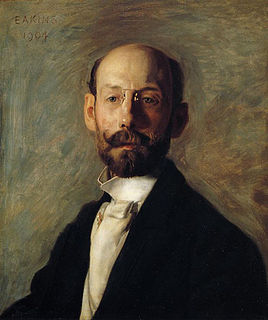
Frank Benton Ashley Linton was an American portrait-painter and teacher. He was a student of Thomas Eakins, studied the École des Beaux-Arts, and won a bronze medal at the 1927 Salon Nationale in Paris. Likely a closeted gay man, he lived with pianist Samuel Meyers for more than thirty years.

Robert Field (1769–1819) was a painter who was born in London, England, and died in Kingston, Jamaica. According to art historian Daphne Foskett, author of A Dictionary of British Miniature Painters (1972), Field was "one of the best American miniaturists of his time." During Field's time in Nova Scotia at the beginning of the nineteenth century, he was the most professionally trained painter in present-day Canada. He worked in the conventional neo-classic portrait style of Henry Raeburn and Gilbert Stuart. His most famous works are two groups of miniatures of George Washington, commissioned by his wife Martha Washington.

Albert Newsam was an American artist. Born deaf and based in Philadelphia, Pennsylvania, he created paintings and drawings, including portraits.

Edward Lionel Loper Sr. was an African American artist and teacher from Delaware, best known for his vibrant palette and juxtaposition of colors. He taught painting for almost 70 years.

Patrick Lyon was a Scottish-born American blacksmith, mechanic and inventor. Following his wrongful imprisonment for a 1798 bank robbery, he wrote a narrative describing his mistreatment, won a large legal settlement, and became a working class hero. A self-made businessman, he designed and built hand-pumped fire engines.

